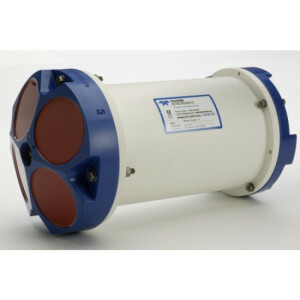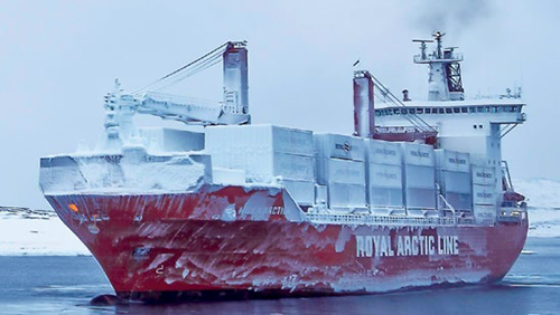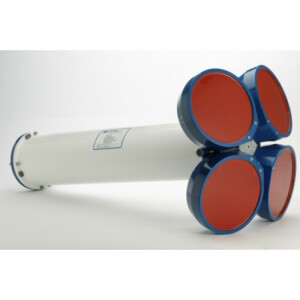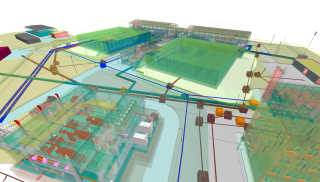

Monitoring Climate Checkpoint with ADCP Transects
For explaining the ocean’s role in the earth’s climate system, oceanographers often point to an overturning circulation in the North Atlantic. It connects surface currents carrying heat poleward (upper limb) with cold, deep currents returning equatorward (lower limb). This system is called the Atlantic Meridional Overturning Circulation (AMOC). Recent observational results show that this system of currents is more complicated than proposed. Yet monitoring key sites within the system remains paramount for climate studies. Find out how this exciting story of Monitoring Upper Ocean Currents unfolds in the full case study.
Sustained VOS-based Current Profiling Across Gateway to Nordic Seas
For explaining the ocean’s role in the earth’s climate system, oceanographers often point to an overturning circulation in the North Atlantic. It connects surface currents carrying heat poleward (upper limb) with cold, deep currents returning equatorward (lower limb). This system is called the Atlantic Meridional Overturning Circulation (AMOC).
Recent observational results show that this system of currents is more complicated than proposed. Yet monitoring key sites within the system remains paramount for climate studies.
One lynchpin is deep water formation. This occurs in several subpolar Seas, located adjacent to the North Atlantic. Waters at the surface lose their heat to the atmosphere and then sink to great depths. The process occurs in convective cells. Observing these cells is mostly happenstance. Thus, researchers opt to measure the integrated result for a region. One example is monitoring the deep overflow through the Faroe Bank Channel.
Tom Rossby (University of Rhode Island) and Charles Flagg (State University of New York) anticipated that changes in the warm Atlantic inflow (upper limb of AMOC) might be a forerunner to changes in deepwater formation. They looked to establish long-term monitoring at key sections across 60°N. The researchers wanted to clarify pathways and volume fluxes of Atlantic Waters into the Nordic Seas.

An automated ADCP-based system is aboard Nuka Artica - a VOS vessel. It runs 60°N between Greenland and Denmark (Photo: Courtesy of Royal Arctic Line A-S, Greenland - www.ral.gl)
SITUATION
For 25 years,Tom Rossby and Charles Flagg have repeated weekly ADCP transects to study the currents of the Gulf Stream. They devised an automated system for use on volunteer observing ships (VOS).
Once their VOS-based current profiling system was proven, Rossby and Flagg applied it to study the AMOC. In 1999, they began repeated transects across 60°N at the gateway to the Nordic Seas.
Together with colleagues at University of Bergen (Norway), the researchers fitted a Teledyne RDI 150 kHz ADCP in the hull of M/V Nuka Arctica (nuka.uib.no). This container ship runs between Greenland and Denmark, making a 3-week round trip. The ship sails on two different tracklines — outbound vs. inbound. The first program ran for four years.
In late 2012, the program using Nuka Arctica restarted. Now using a Teledyne RDI phased array 75 kHz ADCP, the VOS work is an ongoing partnership with Henrik Søiland and other researchers from Norway (Institute of Marine Research).
About a decade ago, Rossby and Flagg added another Nordic section. They rigged a high-seas ferry (M/F Norröna) that makes weekly runs between Denmark and Iceland. For the ADCP, they opted for a 75 kHz TRDI Ocean Surveyor for deeper measurements.
After the ADCP was first installed aboard Norröna, much effort went to rectify issues due to acoustic inference from bubbles. The determination of these researchers has paid off. Early results revealed some key findings about pathways of the currents.

Schematic of currents at eastern gateway to Nardic Seas. Red arrows suggest pathways of Atlantic Water. Deep currents are white. (Credit: Keith Mutch and Mhairi Sinclair - Marine Scotland Science)
SOLUTION
Underway velocity profiling with a shipboard ADCP provides 2D spatial transects — along the ship’s path and through depth. These transects can show detailed patterns of subsurface current systems. Two different types of measurements are merged: water velocity seen by the ADCP and ship velocity.
Measuring deep ocean currents requires that ADCPs operate at low frequencies, such as 75 and 38 kHz. Yet, on a fast-moving ship, maintaining data quality requires narrow acoustic beams. To achieve this balance, Teledyne RDI (TRDI) developed phased array ADCPs.
Operating from a rolling ship in high seas is a hostile environment to make measurements. For example, bubble clouds swept under the hull can degrade sonar performance. And acoustic backscattering conditions affect profiling range. Yet, shipboard ADCP profiles one mile deep (1600 m) have been recorded.
Shipboard ADCPs provide much improved horizontal resolution and better spatial coverage compared with other current-measuring methods. VOS ships regularly repeat specific tracklines. Thus, by installing ADCPs on VOS ships, researchers can collect long time series of repeated, well-resolved transects of currents.
The VOS-based ADCP data sets report currents with an accuracy of 1 cm/s, close along track (2.5 km) spacing, and deep into the ocean (>700 m). This provides detailed coverage of the velocity field. It also provides a unique basis for recording directly the volume of water transported by the upper waters.
The resulting data sets reveal the mean state and variability of the circulation. In their ongoing study of the subpolar North Atlantic, Rossby and Flagg have demonstrated the power of this method.
During a single transect in this region, the mean flow is masked by the eddy velocity field. Yet the mean flow emerges when many transects are averaged. Narrow mean flows steered by major subsea ridges were clear. The averaged data also showed well-defined pathways through the principal basins.
Early work reported volumes of water transported in the upper 400 m. Later, these researchers used deeper ADCP profiles as part of wide-ranging calculations: from validating satellite altimetry results to estimating poleward heat flux of the AMOC.
RESULTS
Two decades ago, Tom Rossby and Charles Flagg began ADCP transects to monitor at key sections across 60°N. The researchers wanted to clarify pathways and volume fluxes of the AMOC. Their initial reports focused on results from each VOS (Nuka Arctica, Norröna). More recent reports co-authored with European scientists merged data sets from other technologies. These reports also examined concurrent sections from both ships. As well, they compared circulation results collected more than a decade apart.

Composite ADCP section (M/F Norröna): Iceland (L) to Scotland (R); Upper: Average flow (m/s) into Nordic Seas, shown with seabed depth; Lower: Cumulative volume of water flowing into the Nordic Seas - integrated from the east (Credit: Childers et al. 2015)
Early results revealed some key findings that sparked debate about pathways of the currents. One example is recirculation in the Faeroe-Shetland Channel. Notably a southward current east of the Faroes was larger than expected and important for calculating net inflow to the Norwegian Sea. This flow has been weaker during recent years. Spatial patterns in the long-term data sets showed statistical significance; e.g., more southward flow off Faroes correlated with increased poleward flow off Scotland — a counterbalance in total transport.
The ADCP’s direct and closely-spaced (2.5 km) measurements reveal narrow mean flows, such as those over seabed topography. The VOS work highlighted the effect of the mid-ocean ridge south of Iceland: on each flank are distinct pathways of the AMOC’s upper limb. Distinct narrow flows are harder to discern with current meter moorings, hydrographic sections, or satellite altimetry. These methods unavoidably average currents over wide distances.

Volumes of water transported into Nordic Seas, measured along VOS routes - Nuka Artctica, Upper route: Norröna (Credit: Childers at al. 2015)
Along each of the three Nuka Arctica and Norröna routes, the researchers calculated cumulative volumes for water transport (beginning on the eastern side). The resulting contour map showed distinctive pathways through the region. In particular, the map reinforced the importance of accurately measuring narrow currents.
When the researchers compared their two ADCP studies from Nuka Arctica — 13 years apart — they calculated almost the same upper-ocean transport between Greenland and Scotland. They reported a mean transport for the AMOC of about 18 million cubic meters per second. This is about half the volume of water flowing through the Florida Straits — nozzle of the Gulf Stream. They also found largely unchanged transports for currents flanking the mid-ocean ridge.
Merging the VOS-based ADCP data sets with XBTs, satellite altimetry, and Argo drifters (profiling to 2000 m) produced important results. These included direct and accurate estimates of not just volumes transported by the AMOC, but its heat and freshwater fluxes between Greenland and Scotland.
Combining ADCP currents with concurrent XBT temperature profiles enabled calculation of poleward heat flux to the Nordic Seas. This tied back to the original motivation for the work: to examine whether changes in the warm Atlantic inflow (upper limb of MOC) might be a forerunner to changes in deepwater formation.
Do you have questions about this case study?
Get in touch with Teledyne Marine, and they would be happy to answer any questions you have about pricing, suitability, availability, specs, etc.










